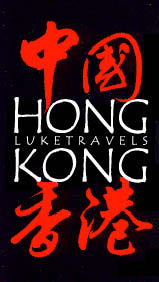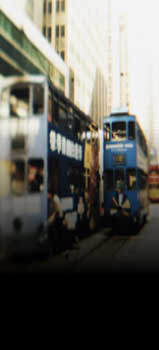| |
 Hong Kong: Getting Around
Hong Kong: Getting Around
 Hong Kong's Backbone
Hong Kong's Backbone
The Mass Transit Railway (MTR) is the best way to get around the city. Built in a record five years, the initial system of this US$5 billion dollar underground was opened in late 1979 to serve the Central District of Hong Kong Island, Nathan Road, and east and north Kowloon. A Tsuen Wan extension and the Island Line are now completed. More expensive than bus or ferry, the MTR is speedy and clean and easy to use. Pick up the MTR guidebook, which explains everything well. The HKTA publishes the complimentary booklet Places of Interest by Public Transport, full of helpful hints, maps, and route advice.
You haven't been to Hong Kong until you have crossed the harbor via the Star Ferry, still the most romantic and inexpensive way to commute. Daily service between Edinburgh Place on Hong Kong Island and the clock-tower terminal in the Tsim Sha Tsui section of Kowloon departs every five minutes 6:30 AM–11:30 PM daily.
The second most popular transportation experience is the Peak Tram, a cog-wheel railway departing from its own station on Garden Road. Since 1888, this funicular railway has been carrying local residents and breathless visitors to the top of "the Peak" for the best view in town. There are five intermediate stops. Have a good walk around at the top before you settle down for tea. There's a good path down for the energetic.
There are also 162 double-decker trams (in business since 1904) rambling noisily but regularly along the North Shore of Hong Kong Island only, from Kennedy Town (far west) through Western District, Central, Wan Chai, Causeway Bay, and ending in Shau Kei Wan at the eastern end. You can make the entire 14-kilometer (9-mile), 65-stop trip in about 90 minutes and get a tour of the "real" Hong Kong.
There are three taxi areas in Hong Kong: Hong Kong Island (red taxis), New Territories (green), and Lantau Island (blue). All taxis are air-conditioned and metered, and most are licensed to carry five passengers. Although many drivers understand English, it's a good idea to ask your hotel desk staff to write your intended destination in Chinese, or ask the door attendant to tell the driver. Taxis are scarcest around 4 PM, when the shifts change.
 Hong Kong Transportation System
Hong Kong Transportation System
Subway - the MTR has 4 lines that run through most of Hong Kong and Kowloon. MTR has a zone based
fare system (like that of Washington DC's Metro) so you pay according to how far you are going. Fares tend to run about HK$5-HK$20, none of which are more than $5 US. Best choice for those who don't know their way around, as all stops are clearly marked.
Bus -there are several different bus companies in Hong Kong and several types of buses. On Hong Kong island there's Citybus (which runs a fleet of mostly
air conditioned double-decker buses) and probably a few smaller operators. In Kowloon there's Kowloon City Bus (much like Citybus) and several light bus operators. Fares for the bus are also zone based, and tend to be fairly cheap-Usually less than $2 US. Express buses are always more expensive than non-express. Choice of destinations can be slightly bewildering so if you need help, ask someone on the bus. For a hair-raising ride, ride a double-decker bus through the mountains on Hong Kong Island...all the fun of a
roller coaster at a bargain price.
Tram - there's a double-decker electric tram (trolley car) that serves almost all of Hong Kong island. While slow and
un-air conditioned, it's very cheap HK$2 for adults, and a great way to see almost all of Hong Kong island while sitting down and rolling along 2 stories above the street. Avoid during
rush hour as there will be nowhere to sit.
Ferries - Will take you across the harbor between Hong Kong and Kowloon. Between Hong Kong and Kowloon are the Star Ferry (which is HK$2.20 on the upper deck, and $1.20 on the commuter's deck), and a few
hover-ferry services which are faster, and cost about HK$4. Ferry services to the islands and Macau can be found in Kowloon and Hong Kong. In Hong Kong go to Sheung Wan (Shun Tak Center-for the jetfoils to Macau) and the ferry piers to outlying islands. Here you can get a ferry to almost anywhere for about HK$10 on weekdays, HK$14 on weekends. Helpful hint - don't go on weekends as both the ferries and the islands will be crowded.
Electric train - The KCR railroad goes from Kowloon to Mainland China and the New Territories. It works
a lot like MTR and fares are similar although a bit higher since you are traveling much further in general. To get to the KCR, take the MTR to Kowloon Tong where the MTR intersects with the KCR line.
Light rail - there is a light rail service between New Cities, and
various parts of the New Territories.
Taxi - if you absolutely don't know your way around, or are carrying around a lot of luggage, you may find yourself needing a taxi. Taxis are widely available and relatively cheap compared to most of the rest of the world. They are metered and
flag-fall starts at HK$15. Be warned though, most taxi drivers speak almost no English so have your destination written in Chinese by a concierge or a friend or you might be taken somewhere other than where you had in mind.
Water Taxi - these can be found in areas with Harbors. Most are
intended to ferry people living in sampans to shore. Some will take
you out to the floating restaurants in Aberdeen, on harbor tours,
and some even go to small outlying islands. These in general are
only recommended for people who speak Cantonese as it is relatively
unlikely you will be able to communicate to the operator where
exactly you want to go if you can't.



|
|

